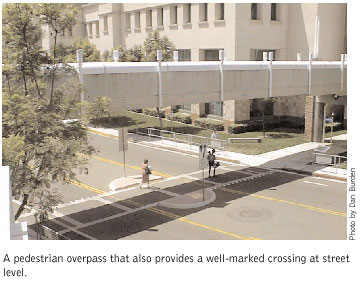7. Pedestrian Overpasses/Underpasses
Pedestrian overpasses and underpasses allow for the uninterrupted flow of pedestrian movement separate from the vehicle traffic. However, they should be a measure of last resort, and usually it is more appropriate to use traffic calming measures or install a pedestrian activated signal Overpasses are often suggested as a way of preventing motor vehicle flow from being impeded by pedestrian traffic and give an environment a feel more akin to a highway, which is where they are most appropriate. This is also an extremely high-cost measure.
Such a facility must accommodate all persons as required by ADA. These measures include ramps or elevators. The extensive ramping required to accommodate wheelchairs will also accommodate bicyclists, but requires long crossing distances and discourages use.
Studies have shown that many pedestrians will not use an overpass or underpass if they can cross at street level in about the same amount of time. Overpasses work best when the topography allows for a structure without ramps (e.g. overpass over a sunken freeway). Underpasses work best when designed to feel open and accessible. Grade separation is most feasible and appropriate in extreme cases where pedestrians must cross roadways such as highways, high speed, and high volume arterials.

Purpose:
- Providing complete separation of pedestrians from motor vehicle traffic.
- Providing crossings where no other pedestrian facility is available.
- Connecting off-road trails and paths across major barriers.
Considerations:
- Use sparingly and as a measure of last resort. Most appropriate over busy, high speed high-ways.
- Pedestrians will not use if a more direct route is available.
- Lighting, graffiti removal and security are also major concerns with underpasses.
Estimated cost
$500,000–$4 million depending on site characteristics.